Things to do in Trinidad
A holiday in Trinidad provides an enchanting taste of traditional Cuba. The centre of Trinidad is a living colonial museum where visitors can enjoy evenings of salsa performances in the central square, and where bars serve up delicious mojitos. Attractions include the largest church in Cuba, Iglesia Parroquial de la Santisima. An extraordinary white interior makes the church feel light, cool and vast. So much of Trinidad's charm is owed to its well-preserved colonial architecture. The Museo Historico Municipal, Trinidad Architecture Museum and the Museo Romantico are all stunning examples of mansions that have been turned into museums. They house collections composed largely of the private belongings and art of the wealthy and influential families that once lived in them. Both are on the Plaza Mayor, the old town square.
Trinidad is also remarkably well situated for excursions out into the countryside. It is just a few minutes' drive from one of Cuba's loveliest beaches, Ancon, and the Embalse Hanabanilla lake and waterfalls, which are immensely popular with hikers and cyclists. Also nearby is the beautiful and historically absorbing Valle de los Ingenios, while it hardly takes any time to reach the nearby city of Sancti Spiritus, a continuation of the rustic colonial glory of Trinidad.
The best time to travel to Trinidad is during the cool, dry months between December and April, which is high season for tourism in Cuba. The weather is sweltering, humid and wet for the rest of the year.
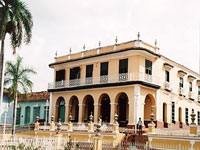
Museo Romántico
Museo Romántico overlooks Plaza Mayor, the historic centre of Trinidad and a UNESCO World Heritage Site. The mansions and palaces surrounding the square date back to the 18th and …
Museo Romántico
Museo Romántico overlooks Plaza Mayor, the historic centre of Trinidad and a UNESCO World Heritage Site. The mansions and palaces surrounding the square date back to the 18th and 19th centuries, when trade in sugar and slaves brought huge wealth to the area. Also called Brunet Palace, the Museo Romántico mostly displays the personal collections of paintings, furniture and porcelain belonging to its previous owners. While the plaza and nearby houses are all unmissable attractions in Trinidad, the neoclassical Museo Románticoi is itself magnificent, with original marble floors and splendid frescoes.
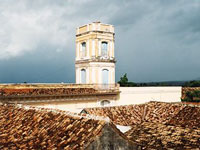
Museo Histórico Municipal
The grandiose Museo Histórico Municipal is a beautiful site. Previously owned by one of the richest families in Cuba, there are murals depicting well-known classical scenes and it…
Museo Histórico Municipal
The grandiose Museo Histórico Municipal is a beautiful site. Previously owned by one of the richest families in Cuba, there are murals depicting well-known classical scenes and its rooms are outfitted in decorative splendour. Exhibits hark back to its original past, covering the sugar industry and history of Trinidad, including collections of weaponry, furniture and art. One of the most popular attractions of this neoclassical mansion is the captivating view from its tower, capturing wonderful vistas of Trinidad and the Escambray Mountains.
Address 423 Simón Bolívar
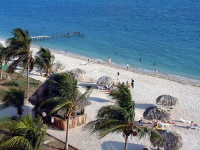
Ancón Beach
Situated seven miles (12km) south of Trinidad at the end of the peninsula, Playa Ancón boasts soft sand, warm waters and a fitting backdrop of palm trees. There are many waterspor…
Ancón Beach
Situated seven miles (12km) south of Trinidad at the end of the peninsula, Playa Ancón boasts soft sand, warm waters and a fitting backdrop of palm trees. There are many watersports at Playa Ancón, as well as good offshore snorkelling and dive sites. Scuba enthusiasts will revel in this underwater playground of rock tunnels and colourful coral. Visitors can guide yachts through the beach's surrounding waters to find that perfect swimming spot or even hire boats to go fishing or exploring along the coast. Travellers also enjoy the countryside while taking a leisurely bicycle ride to Playa Ancón from Trinidad, passing through a picturesque old village on the way.
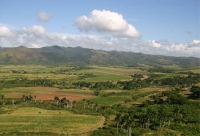
Valle de los Ingenios (Valley of the Sugar Mills)
This emerald valley was once the centre of the sugar industry in Cuba in the 18th and 19th centuries. At its peak, there were over 70 sugarcane mills and about 30,000 slaves workin…
Valle de los Ingenios (Valley of the Sugar Mills)
This emerald valley was once the centre of the sugar industry in Cuba in the 18th and 19th centuries. At its peak, there were over 70 sugarcane mills and about 30,000 slaves working on the plantations. Today, the ruins of estates and mills are visited by tourists attracted by the region's beauty and its historical significance in the slave trade during the valley's boom years. The main site is the Manaca Iznaga, a striking 144ft (44m) high tower which was used by plantation owners to keep watch over slaves. Along with Trinidad, the Valle de los Ingenios has been declared a UNESCO World Heritage Site, and riding tours are a popular way to take in the area's lovely views.
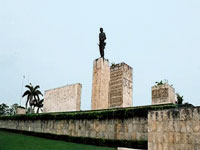
Santa Clara
The city of Santa Clara is best known for the Che Guevara Mausoleum and other monuments relating to the Cuban Revolution. The Tren Blindado marks the spot where Guevara attacked th…
Santa Clara
The city of Santa Clara is best known for the Che Guevara Mausoleum and other monuments relating to the Cuban Revolution. The Tren Blindado marks the spot where Guevara attacked the train carrying Batista's troops and derailed the tracks with a bulldozer. The Mausoleum was built to pay homage to the memory of Guevara and his comrades who fought with him in Bolivia, and the enormous monument incorporates a huge statue of his likeness, as well as representations of many aspects of his revolutionary life. To one side of the statue, a huge stone block has been inscribed in full with his farewell letter to Fidel Castro.
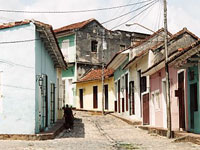
Sancti Spiritus
Sancti Spiritus lies on the banks of the Yayabo River, its delightful architecture and winding cobblestone streets exuding charm, authenticity and friendliness. Pedestrians enjoy i…
Sancti Spiritus
Sancti Spiritus lies on the banks of the Yayabo River, its delightful architecture and winding cobblestone streets exuding charm, authenticity and friendliness. Pedestrians enjoy ice-creams flavoured with fruit, while dodging jams of horse-drawn carriages, bicycles and scooters. The old town is a National Monument dating back to 1514, filled with stately colonial homes and colourful houses beneath red tile roofs. It also boasts the Parroquial Mayor, Cuba's oldest church, and the Puente Yayabo, a bridge over the river that is the city's most famous sight. The city is the birthplace of many famous Cuban musicians, so it's worth checking out the local music scene.



